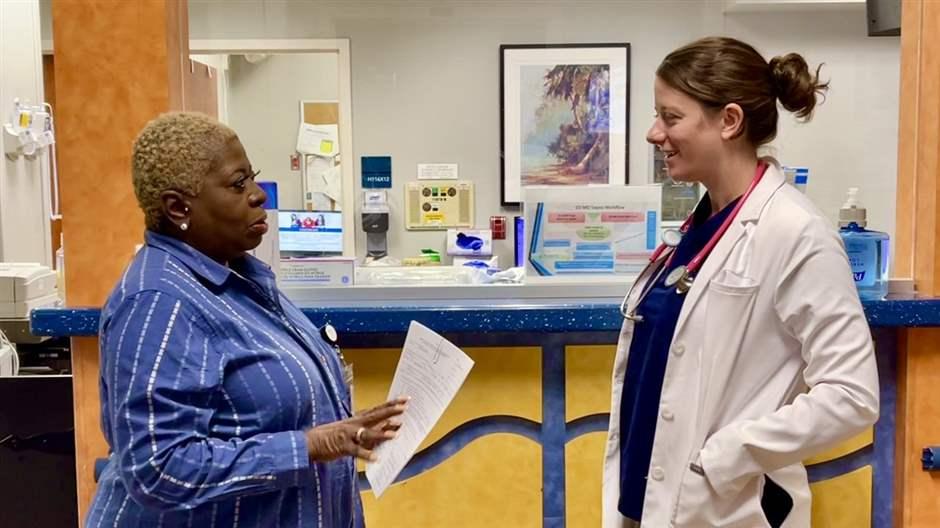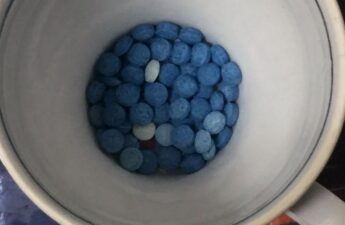
By Christine Vestal
Stateline
CHARLESTON, S.C. — Even in this easygoing, subtropical city, the onset of winter and the stress of the holidays can test the mettle of anyone trying to quit opioids.
“As soon as temperatures start to drop and it gets chilly in the mornings, we see more people coming into the emergency department looking for help,” said Dinah Collins, a peer support specialist at the Medical University of South Carolina in Charleston.
Collins — who has been in recovery from drug use for 27 years — or another peer support specialist is on duty in the hospital’s emergency department around the clock, seven days a week, and the hospital stocks the addiction medications methadone and buprenorphine to stabilize patients in withdrawal from opioid use.
In addition, emergency physicians can write short-term prescriptions for buprenorphine to tide over patients until they can find addiction treatment.
Medical professionals and addiction treatment advocates have long argued that buprenorphine, which is approved by the U.S. Food and Drug Administration, should be available in every emergency room in the country — just like drugs for heart attacks, strokes and diabetic emergencies.
And they argue that emergency physicians should have basic training in addiction medicine and be licensed to write a take-home prescription for buprenorphine.
But so far, adoption of the practice in overburdened emergency departments has been sluggish, despite the nation’s spiraling overdose crisis and a persistent shortage of addiction treatment outside hospitals.
According to a recent study conducted by the University of Michigan, only 8.5% of 149,000 drug-related visits to emergency departments between August 2019 and April 2021 resulted in a prescription for buprenorphine or the overdose reversal drug naloxone for future emergencies.
Last year, 109,000 people died from a drug overdose, more than double the number in 2015.
Holiday Blues
On a sunny morning in early December, Collins’ first addiction patient of the day was a middle-aged man who was transported to the emergency department by ambulance.
A restaurant worker in downtown Charleston, the patient said he’d been feeling low and had stopped going to his methadone clinic three days before. He was doubting himself, Collins said, and worried he didn’t have the strength to beat his addiction. After a year and a half in recovery, he had been using drugs again.
“I suggested he get involved in a local recovery group and find a sponsor he could call when he needed extra support,” Collins said. A physician on staff gave him a dose of methadone before he left and a naloxone kit in case he or one of his friends experienced an overdose. Collins and the patient traded phone numbers, and she told him she’d follow up in a few days to ensure he found the support he needed.
RELATED TATELINE STORY
Opioid Deaths Spark Push to Ease Buprenorphine Rules
In eight of South Carolina’s 67 hospitals, emergency department practitioners screen all patients for substance use disorders and offer treatment to those who screen positive. They also treat patients like the restaurant worker who relapsed, patients brought in because of an overdose and those who are actively using drugs but say they want to quit.
Nationwide, holidays tend to be the busiest times for emergency departments. “People start feeling depressed and start drinking and drugging. It’s to be expected,” Collins said. “I tell patients there’s no better people to be around during these times than the ones who are actually doing the hard work of staying clean.”
Timesaving and Effective
Emergency departments everywhere have been slammed since the COVID-19 pandemic began, which has made it more difficult for advocates to persuade them to add yet another medication and another set of services to their daily routines.
But hospitals that have added addiction treatment to their roster of emergency department services say that it has reduced staff time, said Sarah Windels, national program director at CA Bridge, a nonprofit that promotes emergency department buprenorphine programs.
Instead of providing ibuprofen, acetaminophen, anti-nausea drugs and IV fluids to ease the pain, vomiting and diarrhea that accompanies withdrawal from opioids, emergency practitioners can quickly stabilize patients with a dose of buprenorphine, she explained.
Within minutes after taking buprenorphine by mouth, patients in withdrawal feel better, their heads clear and many want to talk about finding treatment. For patients who aren’t in withdrawal but want to quit and don’t know where else to go, emergency physicians can write a short-term prescription for buprenorphine for home use.
Many hospitals worried that people with addiction wouldn’t follow up with treatment and would keep coming back to the emergency department for medication. That hasn’t happened, Windels said. Many hospitals say the program has reduced emergency visits because more patients are getting into treatment, she said.
Peer support specialists such as Collins are considered the heart of the program. They discuss treatment options, follow up with appointments and stay in touch with patients after they leave.
As recovered drug users themselves, peer counselors can connect with patients. Meanwhile, busy physicians and other licensed practitioners write the prescriptions, administer the medications and get back to other emergencies.
Carrots and Sticks
First tested at Yale New Haven Hospital in 2009, using buprenorphine to stabilize emergency department patients in opioid withdrawal has proven to be effective at getting people into treatment.
Last year, the American College of Emergency Physicians published easy-to-follow instructions for initiating buprenorphine, which experts say has standardized the procedure.
And with more federal money available for addiction treatment and billions to come from a nationwide opioid settlement, addiction treatment advocates say they’re hopeful that the use of buprenorphine in emergency departments will take off, eventually becoming the standard of care for all hospitals.
“This is not about resources or a shortage of trained emergency staff,” said Dr. Elizabeth Samuels, an emergency physician and assistant professor of emergency medicine at Brown University in Rhode Island. “The biggest barrier is stigma and knowledge gaps.”
All 10 of Rhode Island’s hospital emergency departments have been offering buprenorphine since 2016. “The number of people needed to treat with buprenorphine to save a life is incredibly low,” Samuels said.
But Dr. Gail D’Onofrio, who pioneered the program at Yale School of Medicine and continues to run the emergency department at Yale New Haven Hospital, said she’s convinced it will take more than education, money and encouragement for the program to spread.
“This is not a belief system,” D’Onofrio said, “this is evidence-based medicine that people need to adopt. We’ve provided the carrots, but there needs to be a lot of sticks in place too. Without them, people aren’t going to do it, particularly when things are so bad in emergency departments all over the country.”
RELATED STATELINE STORY
In Opioid Settlements, Suboxone Plays a Leading Role
A New York-based addiction treatment advocacy group, the Legal Action Center, is warning hospitals that denying life-saving care for people with substance use disorders may violate a federal law that prohibits emergency departments from turning away people without first stabilizing and treating them.
And some addiction treatment advocates, including Joshua Sharfstein, vice dean at the Johns Hopkins Bloomberg School of Public Health, suggest that hospital quality ratings be based in part on whether their emergency departments provide addiction services.
By the Numbers
In a 2015 report, 78% of patients who received buprenorphine in the emergency department at Yale New Haven Hospital subsequently stayed in treatment for at least 30 days. In contrast, only 45% of patients who did not receive the medication stayed in treatment for 30 days.
By 2016, when the deadly opioid fentanyl began showing up in the illicit drug supply, evidence supporting the use of buprenorphine in emergency departments became even more compelling; studies began showing the addiction medicine also was protecting people from overdose death.
But in 2018, fewer than 60 of the nation’s more than 5,586 hospital emergency departments had started offering addiction treatment. Medical University of South Carolina in Charleston, or MUSC, was one of them.
Dr. Lindsey Jennings, an emergency physician at MUSC, is credited with championing the addiction treatment program there. In her first year as an attending physician, she said, she became frustrated because she couldn’t effectively help patients with withdrawal symptoms who wanted treatment.
“It can take a long time to get to the point where you’re seeking treatment and want to get engaged,” she said. “Emergency departments are the only medical facility open 24-7, and when you’re at that point and you more or less get a Band-Aid and an appointment that’s three or four weeks out, you’re likely to give up and go back to using.”
Jennings had read the 2015 study, authored by D’Onofrio and others at Yale, and asked the hospital what it would take to get a similar program started.
At the same time, Sara Goldsby, director of the South Carolina Department of Alcohol and Other Drug Abuse Services, was inviting the hospital to apply for a grant to jumpstart a buprenorphine program there. She also had read the Yale study.
Now, the American College of Emergency Physicians reports that at least 385 urban and rural hospitals have joined a network of emergency departments that share information on their buprenorphine programs.
In addition, more than 250 hospital emergency departments in California offer buprenorphine and referrals to service, according to CA Bridge, as do 31 hospitals in Maryland, 19 in West Virginia, five in Kentucky and six in Washington, D.C., according to Mosaic Group, a Maryland-based addiction treatment advocate that provides technical assistance to hospitals in those states.
“We still have a lot of work to do to change the hearts and minds of hospital administrators and the will of emergency practitioners to address addiction medically,” Goldsby said. “It goes back to stigma and bias against people with addiction and a lack of understanding of the disease of addiction.”
But even if every hospital in South Carolina were persuaded to adopt an emergency department addiction program, Goldsby said, the state’s addiction treatment funds are tapped out by the eight hospitals that already have them as well as other addiction treatment programs.
Since South Carolina is one of 11 states that has not expanded its Medicaid program to cover low-income adults, providing additional services for adults with addiction in the emergency department wouldn’t be covered.
New opioid treatment funds will become available next year in South Carolina and other states from a $26 billion national opioid court settlement, but it remains to be seen what the priorities will be for those funds.
Goldsby says she’s proud of the work being done at MUSC and seven other hospitals in the state.
But, she said, “The numbers are unacceptable. If this were diabetes and we weren’t getting medicine to people in the emergency department, it would be under federal scrutiny. What if it were up to hospitals to decide whether to give patients insulin or not? Why is it a question as to whether we should stabilize people with addiction?”
Stateline, an initiative of The Pew Charitable Trusts.

